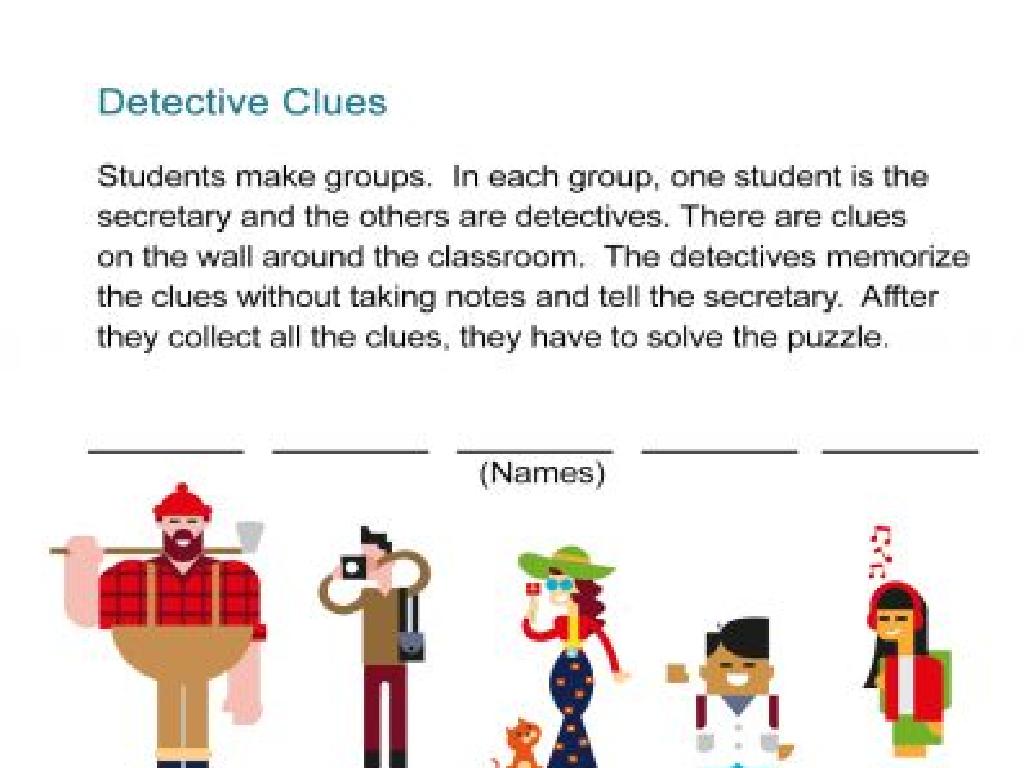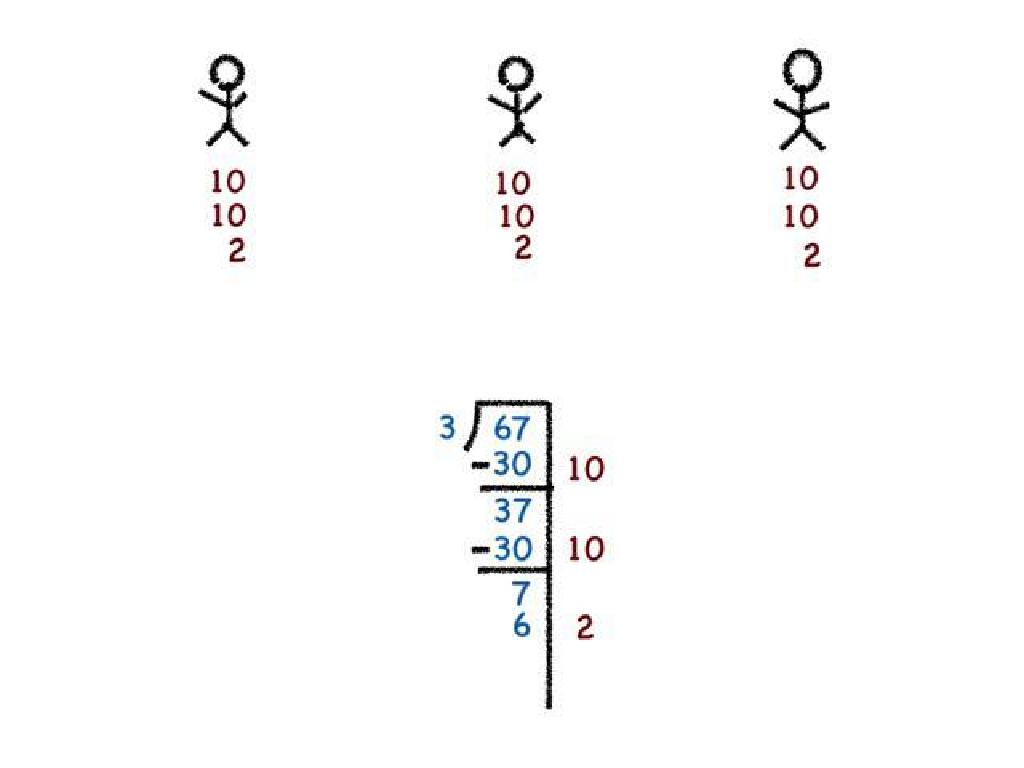Identify Action Verbs
Subject: Language arts
Grade: Third grade
Topic: Verb Types
Please LOG IN to download the presentation. Access is available to registered users only.
View More Content
Exploring Action Verbs
– What are verbs?
– Verbs are words that show action or state of being.
– Importance of verbs
– Verbs are crucial for forming sentences.
– Action verbs animate sentences
– They make our sentences exciting and active.
– Examples of action verbs
– ‘Run’, ‘jump’, and ‘think’ are action verbs.
|
Begin the lesson by explaining that verbs are the part of speech that express action or a state of being. Emphasize the importance of verbs in constructing sentences, as they are necessary to convey what the subject is doing or experiencing. Introduce action verbs as words that show physical or mental actions, bringing energy and clarity to our sentences. Provide examples of action verbs and encourage students to act them out or use them in sentences to solidify their understanding. This interactive approach will help students recognize and use action verbs effectively in their writing and speaking.
Understanding Verbs: Action Words
– Verbs show action or state
– Examples: ‘run’, ‘jump’, ‘is’, ‘are’
– ‘Run’ and ‘jump’ show action, while ‘is’ and ‘are’ show states of being.
– Verbs are central in sentences
– Finding verbs in sentences
– Let’s locate the verbs in example sentences together.
|
Begin the lesson by defining a verb as a word that expresses action or a state of being, which is crucial for students to understand sentence structure. Provide clear examples of action verbs like ‘run’ and ‘jump’, as well as state of being verbs like ‘is’ and ‘are’. Emphasize that verbs are essential to the meaning of a sentence, often referred to as the ‘heart’ of a sentence. Engage the class by asking them to find and highlight verbs in example sentences you provide. This will help them identify action verbs in context and understand their importance in conveying action in narratives and instructions.
Spotting Action Verbs
– Action verbs show what happens
– They can be physical or mental
– Example: ‘She sings.’
– ‘Sings’ tells us her action
– Example: ‘He thinks.’
– ‘Thinks’ is a mental action
|
This slide introduces the concept of action verbs to third-grade students. Action verbs are important in sentences because they tell us what the subject is doing. These verbs can describe physical actions, like running or jumping, as well as mental actions, such as thinking or dreaming. Use examples like ‘She sings’ to show a clear, physical action, and ‘He thinks’ to illustrate a mental action. Encourage students to act out or visualize the actions to better understand and remember the verbs. In the next class, students can be asked to find and share action verbs from their favorite stories or daily activities.
Spotting Action Verbs
– What is an action verb?
– Action verbs show doing
– Words like ‘run’, ‘jump’, and ‘think’
– How to spot them in sentences
– Look for the doing word in a sentence
– Let’s practice finding action verbs!
– We’ll do examples as a class activity
|
This slide introduces the concept of action verbs to third-grade students. Begin by explaining that an action verb is a word that tells us what the subject of a sentence is doing. Emphasize that these verbs are all about action – things you can do. Show them how to identify the action verb in a sentence by finding the word that shows the action. Use simple and relatable examples like ‘The cat runs across the yard’ or ‘She thinks about her homework’ to illustrate the point. For the class activity, prepare sentences with clear action verbs and have students identify them. This interactive approach will help solidify their understanding of action verbs.
Spotting Action Verbs in Sentences
– ‘Barks’ shows what the dog does
– The verb ‘barks’ is an action the dog performs
– ‘Dances’ tells us about Maria’s action
– ‘Dances’ is the action verb showing Maria’s movement
– ‘Learn’ describes our daily activity
– ‘Learn’ is the action verb that tells us about an ongoing activity
|
This slide is aimed at helping third-grade students identify action verbs in sentences. Action verbs are words that show what someone or something is doing. In the examples provided, ‘barks’, ‘dances’, and ‘learn’ are the action verbs that describe the actions of the dog, Maria, and ‘we’ respectively. Encourage the students to not only spot the action verbs but also to use them in their own sentences. This will help them understand that action verbs are a crucial part of a sentence that tells us what action is taking place. Have the students practice by finding other action verbs in different sentences and creating their own examples.
Your Turn: Spot the Action Verb!
– Listen to the sentence carefully
– Find the action verb
– Action verbs are words like run, jump, think, and eat
– Remember, verbs show action
– Get ready to share your answer
|
This slide is for an interactive classroom activity where the teacher will read out sentences, and the students will identify the action verbs within them. Before starting, remind the students that action verbs are words that show what someone or something is doing. Encourage them to listen attentively to each sentence. After you say a sentence, give them a moment to think and then ask for volunteers to share the action verb they identified. Praise their efforts to build confidence. Possible sentences for the activity: ‘The dog barks loudly.’, ‘She paints a beautiful picture.’, ‘We are learning about verbs.’, ‘He jumps over the fence.’ This exercise will help reinforce their understanding of action verbs in a fun and engaging way.
Class Activity: Verb Charades
– Let’s play Verb Charades!
– Each student receives an action verb card
– You’ll get a secret word to perform
– Act out your verb without speaking
– Use body language to express your verb
– Classmates guess the action verb
– Think about the verb and shout your guess!
|
This activity is designed to help students identify action verbs through a fun and interactive game. Each student will receive a card with an action verb on it. They will then take turns acting out their verb in front of the class without using any words. The rest of the class will guess the action verb based on the student’s pantomime. This will encourage students to think creatively about how to express actions physically and will also help them to recognize and understand action verbs in a memorable way. For the teacher: Prepare a list of action verbs suitable for the grade level, ensure each student understands the rules, and encourage participation. Possible verbs include: run, jump, swim, write, clap, and dance.






